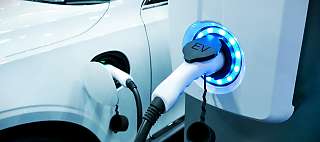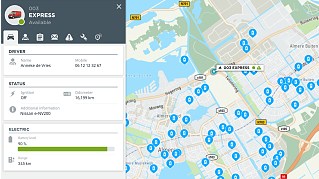Electric vehicle fleet management
Where are you in the electrification journey? Webfleet helps every step of the way to realise an electric vehicle fleet.






Between the cost of fuel and government pressure to become greener, many fleet businesses are looking to EVs and EV fleet management to help lower operational costs and carbon emissions. The electrification of even a small fleet can be quite a journey. Where are you in the process of realising an electric vehicle fleet? We help you plan the transition, add EVs to your fleet and make the right choices to maximise ROI.
Webfleet helps you master EV fleet management
Spot the best vehicles
to switch over to electric, based on milage, efficiency and TCO
Monitor and manage
your ICE and EV fleets on one convenient dashboard
Track data
like range, energy consumption, mechanical status and more with just a click
Measure data
like how exactly driver behaviour and other factors influence your fleet's economy and expenses
Optimising charging choices
by lowering costs, increasing productivity and making a better ROI
Implement the best solution
for your own electric fleet with the help of our EV experts
Key features for customers willing to add EVs to their fleet
Monitor fuel usage and carbon emission dashboard Webfleet
Monitor real-time fuel consumption and emissions responsibility with our fuel efficiency dashboard. Use those insights to spot the best places to begin decarbonising your fleet. Whether your fleet consists of passenger cars, LCVs or anything else, our LINK on-board devices can connect everything to Webfleet and make all your data easily available. Determine which parts of the fleet have the highest emissions and are the best to begin changing into electric vehicles.


Get your fleet electrification report now
Thinking about adding electric vehicles to your fleet but not sure where to start? Our fleet electrification planning report will evaluate your current fleet and recommend which vehicles could be replaced with an electric model for optimal results.
Benefits
If you want to add EVs to your fleet and would like to build a business case, the report helps you to:
- Easily see which vehicles could be replaced with an EV.
- Calculate the potential savings in fuel expenses.
- Calculate the potential savings in CO2 emissions.
Talk to our EV experts
Whether you would like to know more about calculating your current fleet's Total Cost of Ownership (TCO), comparing that to the emissions and costs of a EV or hybrid fleet, or want to know how to smartly electrify your assets, our experts are keen to help.

Key features for customers that have EVs in their fleet
EV charging report
Webfleet's EV charge report helps you track when, where and for how long your electric vehicles were plugged in for charging, giving you insight into why your EVs are at their current level of charge. With this data you will also have insight into the quality of the battery. This way your electric vehicles will always be ready when you need them.


Optimise your workforce charging
Working out when to charge an electric vehicle isn't an issue, with Webfleet. Plan jobs with charging locations displayed directly on the Webfleet map, ensuring that vehicles can efficiently use time and chargers to complete any job.
Find the closest EV charging locations on the road
Your drivers can rely on commercial-grade EV map coverage on their PRO Driver Terminals, displaying charging locations across Australia.


Real-time notifications battery level
Get notified in real-time when the battery of a vehicle on the road approaches a critical level and needs to be charged. With this Webfleet feature, you can quickly take action and prevent breakdowns of service, ensuring seamless operation of your fleet. Stay in control and optimise the performance of your electric vehicles.
EV fleet management made easy
Our Webfleet solution allows you to view, monitor, and manage your ICE, hybrid and electric fleet all on the same platform, while offering support to drivers when necessary. Webfleet can also be integrated with a wide range of 3rd party applications, so you can build the ideal solution for your fleet.


Monitor your electric vehicles from anywhere
Right there in the palm of your hand, you can manage your whole fleet from anywhere using our Webfleet Mobile app. Most of the information is available in one touch and commands are carried out using the same intuitive tap or swipe action you use for other mobile apps.
EV awards
All you need to know about EV fleet management
What is an EV fleet?
0
What is an EV fleet?
0An EV fleet is a collection of vehicles that operate either entirely or partially using electric battery power. These vehicles are designed to reduce reliance on traditional fossil fuels by utilizing advanced battery technologies. There are two main types of electric vehicles (EVs) within an EV fleet:
- Battery Electric Vehicles (BEVs): These vehicles are solely powered by electricity stored in rechargeable batteries. They do not have an internal combustion engine and rely entirely on electric propulsion.
- Plug-in Hybrid Electric Vehicles (PHEVs): PHEVs combine a conventional internal combustion engine with an electric motor and a rechargeable battery. They can operate on electric power alone for a limited range before switching to the internal combustion engine or a combination of both.
EV fleets are increasingly popular due to their environmental benefits, including lower greenhouse gas emissions compared to traditional gasoline or diesel vehicles. They also contribute to reduced air pollution and noise levels in urban environments. Additionally, EV fleets are seen as a key strategy in achieving sustainability goals and reducing the carbon footprint of transportation systems.
What are the key benefits of an electric vehicle fleet?
0
What are the key benefits of an electric vehicle fleet?
0An electric vehicle fleet has some key benefits:
- Lower running costs than ICE vehicles: Eliminating your fleets need for fossil fuels means no need to expense gasoline. On average, an electric vehicle will accrue less than half of the travel costs of an ICE vehicle across the same distance.
- Simpler and cheaper maintenance: EVs have fewer moving parts, which means fleet managers can save thousands a year on maintenance costs, approximately one-third of the cost to maintain ICEs.
- Greater amounts of vehicle data to improve performance: Combined with an electric vehicle fleet management system, the data will help fleet managers monitor and calculate how cost-effective the addition of EVs to their fleet has been.
- Massively reduced carbon footprint: With zero carbon emissions being released, you can help improve air quality.
- Leading the way: EVs offer the chance to be a market leader by adapting quickly to the technological shift.
How is EV fleet management different from fleet management for internal combustion (ICE) vehicles?
0
How is EV fleet management different from fleet management for internal combustion (ICE) vehicles?
0The main difference between managing an EV fleet and one that uses petrol is how you power your vehicles. With internal combustion engines(ICE), it's a matter of filling up at a petrol station. Managing an EV fleet requires planning jobs based on range capacity and re-charges.
How does EV fleet management work?
0
How does EV fleet management work?
0Fleet management technology plays a significant role. You need the ability to monitor your EV locations and charge status, data that's vital to route planning and job completion. Electric vehicle fleet management software gives you greater control with notifications on battery levels. Thinking of switching to EVs? Use our free Fleet Electrification Report to analyse how much you could save on fuel and C02 emissions by going electric. Request a free consultation
What is fleet electrification?
0
What is fleet electrification?
0Fleet electrification refers to the process of transitioning fleets from vehicles powered by internal combustion engines to electric vehicles (EVs). This shift is aimed at reducing emissions and cutting down on fuel costs associated with traditional gasoline or diesel-powered vehicles. By adopting electric vehicles, fleets can also comply with government regulations pertaining to low or zero-emission zones.
What is the difference between electric vehicles and internal combustion engine vehicles?
0
What is the difference between electric vehicles and internal combustion engine vehicles?
0There are three categories of electric vehicles:
- Battery electric vehicles (BEVs)
- 100% electric with rechargeable batteries
- Plug-in hybrid electric vehicles (PHEVs)
- Two options to charge batteries: regenerative braking or plugging into an external power source
- Hybrid electric vehicles (HEVs)
- Electric and gasoline-powered, using regenerative braking to power engines
Internal combustion engine (ICE) vehicles are powered entirely by petrol whereas a lithium-ion battery is used to power EV engines. Therefore, EVs do not emit excessive CO2 or contribute to air pollution in the same way that ICEs do.






Your consent is required
In this section, external content is being embedded from .
To display the content, your consent is required for the following cookie categories:
- Targeted Advertising
- Analytics & Personalization
- Essential
For further details, please refer to our privacy policy. If you are interested in how ###vendor_name### processes your data, please visit their privacy policy.














